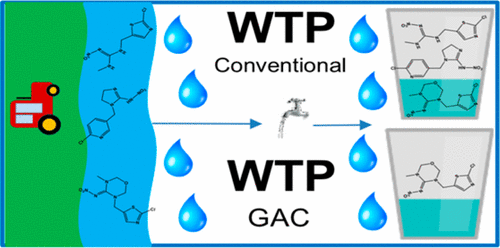Neonicotinoids detected in drinking water in agricultural area

Concern over the use of neonicotinoid pesticides is growing as studies find them in rivers and streams, and link them with declining bee populations and health effects in other animals. Now researchers report that in some areas, drinking water also contains the substances—but they also have found that one treatment method can remove most of the pesticides. The study, conducted in Iowa, appears in ACS' journal Environmental Science & Technology Letters.
Neonicotinoids are potent insecticides that are used widely around the world, often applied to seed coatings of crops. But some research has associated the compounds in certain cases with harm to bees. Other studies have suggested that chronic exposure to the compounds can cause developmental or neurological problems in other animals, too. The pesticides are so commonly used in agriculture that surveys of streams in farming-intensive regions in the U.S. have found that neonicotinoids are widespread in surface waters. Gregory H. LeFevre, David M. Cwiertny and colleagues wanted to investigate the fate of these compounds as water from the Iowa River and an aquifer supplied by the river is treated and ends up at the tap.
The researchers tested water as it went through two different water treatment systems. They found that a system serving Iowa City, which uses granular activated carbon filtration, removed 100 percent, 94 percent and 85 percent of the neonicotinoids clothianidin, imidacloprid and thiamethoxam, respectively. The rapid sand filtration system serving the University of Iowa reduced the same substances only by about 1 percent, 8 percent and 44 percent, respectively. Drinking water samples from this treatment plant contained between 0.24 and 57.3 nanograms of individual neonicotinoids per liter. Regulatory limits for these substances are not currently in place as researchers are still working to understand if and how neonicotinoids impact human health, the researchers note. They add that more studies are needed to figure out whether chronic, low-level exposure to neonicotinoids might be harmful.
More information:
Occurrence of Neonicotinoid Insecticides in Finished Drinking Water and Fate during Drinking Water Treatment , Environ. Sci. Technol. Lett., Article ASAP
pubs.acs.org/doi/abs/10.1021/acs.estlett.7b00081
Abstract
Neonicotinoid insecticides are widespread in surface waters across the agriculturally intensive Midwestern United States. We report for the first time the presence of three neonicotinoids in finished drinking water and demonstrate their general persistence during conventional water treatment. Periodic tap water grab samples were collected at the University of Iowa over 7 weeks in 2016 (May–July) after maize/soy planting. Clothianidin, imidacloprid, and thiamethoxam were ubiquitously detected in finished water samples at concentrations ranging from 0.24 to 57.3 ng/L. Samples collected along the University of Iowa treatment train indicate no apparent removal of clothianidin or imidacloprid, with modest thiamethoxam removal (∼50%). In contrast, the concentrations of all neonicotinoids were substantially lower in the Iowa City treatment facility finished water using granular activated carbon (GAC) filtration. Batch experiments investigated potential losses. Thiamethoxam losses are due to base-catalyzed hydrolysis under high-pH conditions during lime softening. GAC rapidly and nearly completely removed all three neonicotinoids. Clothianidin is susceptible to reaction with free chlorine and may undergo at least partial transformation during chlorination. Our work provides new insights into the persistence of neonicotinoids and their potential for transformation during water treatment and distribution, while also identifying GAC as a potentially effective management tool for decreasing neonicotinoid concentrations in finished drinking water.
Journal information: Environmental Science & Technology Letters
Provided by American Chemical Society


















